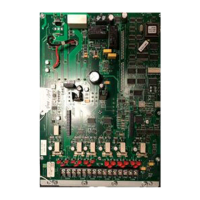LED Indications
LEDs
The amplifier LEDs are summarized in the table below.
Table 4: LED Indications
LED # LED Name Meaning Color
LED1 COMMS TBL Steadily on when the amplifier is not communicating with the system CPU Yellow
LED2 OUT_TBL Steadily on during Power Stage Overcurrent Failure/Output Supervision Trouble Yellow
LED3 IN_TBL
Single blink: input channel 1 failure
Double blink: input channel 2 failure
Steadily on: failure on input channels 1 and 2
Applies to analog input channel or digital audio riser.
Yellow
LED4 AC Pwr Steadily on when AC supply is on Green
LED5 NAC 1 Status Steadily on when NAC 1 is on or in Trouble condition Yellow
LED6 NAC 2 Status Steadily on when NAC 2 is on or in Trouble condition Yellow
LED7 NAC 3 Status Steadily on when NAC 3 is on or in Trouble condition Yellow
LED8 NAC 4 Status Steadily on when NAC 4 is on or in Trouble condition Yellow
LED9 NAC 6 Status Steadily on when NAC 5 is on or in Trouble condition Yellow
LED10 NAC 5 Status Steadily on when NAC 6 is on or in Trouble condition Yellow
Non-Alarm Audio
How to Properly Set Up a System for Non-alarm Audio
There are some conditions under which non-alarm audio (music, paging announcements) may not be broadcast at the full amplifier capacity of 100
watts. To do so may cause the amplifier to cut out with an over-current fault. This is not a potential problem in alarm-only non-alarm audio.
30% of the capacity of an amplifier is reserved for the 20kHz supervision tone which is broadcast along with the desired non-alarm audio. Amplifiers
with a speaker load of 70% or less of the amplifier capacity (70 watts) may broadcast NAA at full volume.
Amplifiers with a speaker load of more than 70% of amp capacity must operate at a reduced NAA level by reducing the input voltage level so that the
power stage current draw does not exceed 100% of the amp capacity. That level is:
• 25V Amp: 4.0A
• 70V Amp: 1.43A
Current should be monitored by broadcasting NAA and observing the real time current reading in the appropriate section of the card status for the
applicable amplifier. Adjust the input level (external music source, microphone adjustment, etc.) for the proper peak current.
Note: The "peak current" reading in the amplifier card status page should not be used because it is affected by inrush on power-up and is never reset.
The reading may be higher than the NAA peak.
page 13 579-174 Rev. Q
Digital/Analog Amplifiers Installation Instructions

